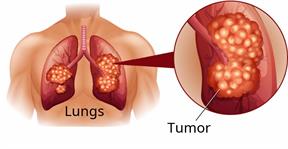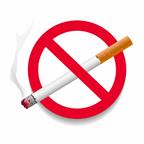Lung Cancer
 Lung cancer is an abnormal growth of cancerous cells that forms a mass (malignant tumor) in a lung. There are several types of lung cancer. The types are based on the appearance of the tumor cells. The two most common types are:
Lung cancer is an abnormal growth of cancerous cells that forms a mass (malignant tumor) in a lung. There are several types of lung cancer. The types are based on the appearance of the tumor cells. The two most common types are:- Non-small cell lung cancer. This type of lung cancer is the most common type. Non-small cell lung cancers include squamous cell carcinoma, adenocarcinoma, and large cell carcinoma.
- Small cell lung cancer. In this type of lung cancer, abnormal cells are smaller than those of non-small cell lung cancer. Small cell lung cancer gets worse (progresses) faster than non-small cell lung cancer.
What are the causes?
The most common cause of lung cancer is smoking tobacco. The second most common cause is exposure to a chemical called radon.
What increases the risk?
You are more likely to develop this condition if:- You smoke tobacco.
- You have been exposed to:
- Secondhand tobacco smoke.
- Radon gas.
- Uranium.
- Asbestos.
- Arsenic in drinking water.
- Air pollution and diesel exhaust.
- You have a family or personal history of lung cancer.
- You have had lung radiation therapy in the past.
- You are older than age 65.
What are the signs or symptoms?
In the early stages, you may not have any symptoms. As the cancer progresses, symptoms may include:- A lasting cough, possibly with blood.
- Fatigue.
- Unexplained weight loss.
- Shortness of breath.
- High-pitched whistling sounds when you breathe, most often when you breathe out (wheezing).
- Chest pain.
- Loss of appetite.
- Hoarseness.
- Bone or joint pain.
- Weakness.
- Change in the structure of the fingernails (clubbing), so that the nail looks like an upside-down spoon.
- Swelling of the face or arms.
- Inability to move the face (paralysis).
- Drooping eyelids.
How is this diagnosed?
This condition may be diagnosed based on:- Your symptoms and medical history.
- A physical exam.
- A chest X-ray.
- A CT scan.
- Blood tests.
- Sputum tests.
- Removal of a sample of lung tissue (lung biopsy) for testing.
Your cancer will be assessed (staged) to determine how severe it is and how much it has spread (metastasized).
How is this treated?
Treatment depends on the type and stage of your cancer. Treatment may include one or more of the following:- Surgery to remove as much of the cancer as possible. Lymph nodes in the area may be removed and tested for cancer as well.
- Medicines that kill cancer cells (chemotherapy).
- High-energy rays that kill cancer cells (radiation therapy).
- Targeted therapy. This targets specific parts of cancer cells and the area around them to block the growth and spread of the cancer. Targeted therapy can help limit the damage to healthy cells.
- Immunotherapy. This treatment uses a person's own immune system to fight cancer by either boosting the immune system or changing how the immune system works.
Follow these instructions at home:

-
Do not use any products that contain nicotine or tobacco. These products include cigarettes, chewing tobacco, and vaping devices, such as e-cigarettes. If you need help quitting, ask your health care provider.
-
Do not drink alcohol.
-
If you are admitted to the hospital, make sure your cancer specialist (oncologist) is aware. Your cancer may affect your treatment for other conditions.
-
Take over-the-counter and prescription medicines only as told by your health care provider.
-
Work with your health care provider to manage any side effects of treatment.
-
Keep all follow-up visits. This is important.
Where to find support
Consider joining a local support group for people who have been diagnosed with lung cancer.
Where to find more information
-
American Cancer Society: www.cancer.org
-
National Cancer Institute (NCI): www.cancer.gov
Contact a health care provider if you:
-
Lose weight without trying.
-
Have a persistent cough and wheezing.
-
Feel short of breath.
-
Get tired easily.
-
Have bone or joint pain.
-
Have difficulty swallowing.
-
Notice that your voice is changing or getting hoarse.
-
Have pain that does not get better with medicine.
Get help right away if you:
-
Cough up blood.
-
Have chest pain or new breathing problems.
-
Have a fever.
-
Have swelling in an ankle, leg, or arm, or the face or neck.
-
Have paralysis in your face.
-
Are very confused.
-
Have a drooping eyelid.
These symptoms may represent a serious problem that is an emergency. Do not wait to see if the symptoms will go away. Get medical help right away. Call your local emergency services (911 in the U.S.). Do not drive yourself to the hospital.
Summary
-
Lung cancer is an abnormal growth of cancerous cells that forms a mass (malignant tumor) in a lung.
-
There are several types of lung cancer. The types are based on the appearance of the tumor cells. The two most common types are non-small cell and small cell.
-
The most common cause of lung cancer is smoking tobacco.
-
Early symptoms include a lasting cough, possibly with blood, and fatigue, unexplained weight loss, and shortness of breath.
-
After diagnosis, treatment depends on the type and stage of your cancer.
This information is not intended to replace advice given to you by your health care provider. Make sure you discuss any questions you have with your health care provider.

